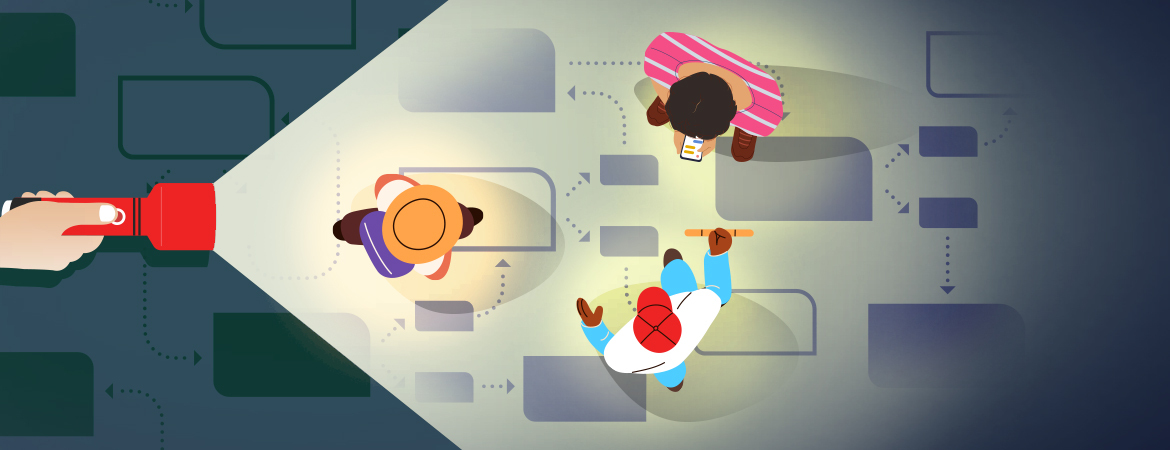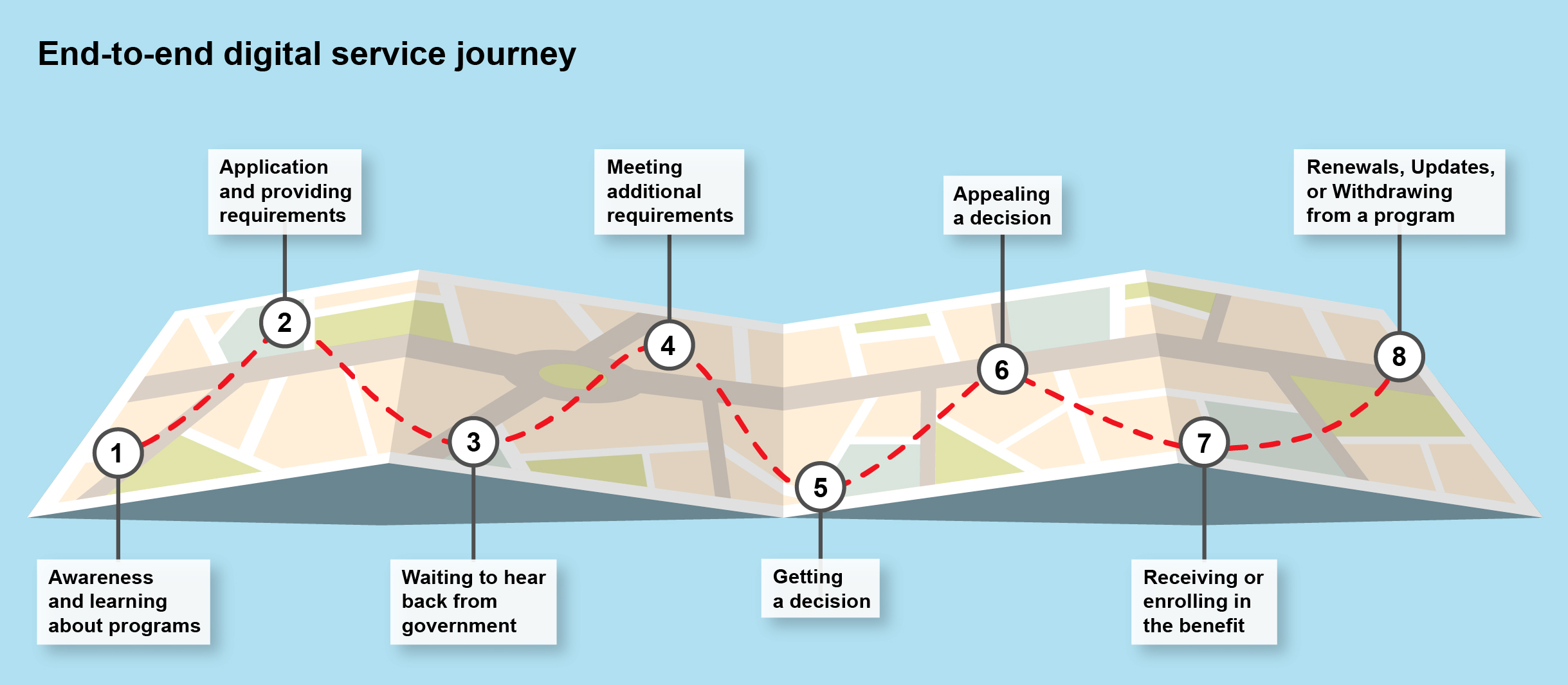
Last summer, we published CDS’s strategic vision for the next 3 years, with a plan for enabling digital service delivery across the GC. As part of this, we shared a draft of our vision of an end-to-end service journey (Annex 1). In this 2-part series, we’ll dig a bit deeper into what that means and the thinking behind our end-to-end vision. We’ll also share a framework to help underpin conversations about how to deliver great services.
My name is Beth Fox and I am the manager of strategic data and reporting at CDS. I’m passionate about doing this, because the way programs and services are delivered is complex and usually a collection of the work of a number of different domain experts and types of work. Many of us experience and sense the system that is required to deliver services, but we don’t always have a map to navigate it. By making it visible and naming the parts, we’re hoping we can unlock more fruitful conversations about who’s working where, what’s influencing outcomes, and how we can all contribute to service improvements. My hope is with a shared map and language to describe this work, we can collaborate in a coherent way that avoids missed opportunities or the confusion that sometimes comes from people or teams at different vantage points unintentionally working at cross purposes.
I’ve worked on all kinds of services at various levels of government. I’ve seen hundreds of people test and use services, and I’ve worked with countless public servants in various multidisciplinary teams. At CDS, our collective experience with teams and services gives us a systemic view of the things that are similar across service delivery. We see repeatedly how the best outcomes are achieved when we have everyone working together across both the end-to-end and front-to-back. Let’s start by defining what we mean by end-to-end.
What do we mean when we say end-to-end?
End-to-end means all the steps and interactions a person has to complete to achieve their goal (such as apply for a permit, renew something, etc). Often, these steps cross organizational boundaries, with different teams handling different parts of the process.
Some interactions have just a few steps, like searching for a program detail like a deadline or payment date, or submitting a record. We might not think of them as services, but this simple interaction relies on several bits working together, like search and keyword optimization, content publishing, and sometimes viewing data registries or information repositories.
Other more transactional services, like a certification or licensing, could have many steps and require signing in, updating information, or paying a fee. Major milestones or “life events” might require you to use multiple services over an extended period of time, like retiring, immigrating, or starting a business. The end-to-end of specific services is varied and changes over time. It can also be more simple or complex depending on the situation of the person accessing a service.
Defining common language for the end-to-end
The idea of mapping the end-to-end of services isn’t new, and it doesn’t need to be something teams start from scratch every time. We’ve started by defining a simplified vision for the main steps in an end-to-end that could apply to the majority of government services. They’re based on the experience we have, the patterns we’ve seen across many services, and our experience observing how people use services and the words they use to describe them.
We were intentional about using the language we’ve heard time and time again in research and usability testing to provide a people-centred definition of the outcome of those steps. We believe that labelling and defining the steps of a service in this way is important. It helps centre discussions, designs, and decisions about a service around the needs of the people who use them (vs. the perspective of the organizations delivering them).
We took CDS’s strategy with detailed steps for delivery and simplified it for wider relevance/applicability. The steps listed below expands on what we propose are the common steps across many GC services. We’re hoping that if teams across government can start using common language to describe these things, we might also be able to see where we can reduce duplicative efforts, and share the load of designing and delivering services that are similar.
8 common end-to-end steps across many GC services
1. Awareness and learning about programs:
- People are made aware of, and can find the program online.
- They are able to understand eligibility and learn how to apply.
2. Application and providing requirements:
- People can confidently complete forms without errors, attach documents or proof of credentials if required.
- Regardless of how people seek a service, they have an experience that meets modern expectations.
3. Waiting to hear back from government:
- The stress of waiting is reduced through clear communication of updates on progress.
4. Meeting additional requirements:
- Complicated or multi-step journeys are supported between channels so people can use the phone or in-person services when needed.
5. Getting a decision:
- Decisions are communicated in timely and appropriate ways.
6. Appealing a decision:
- Appeals are supported so people aren’t “starting over”.
7. Receiving or enrolling in the benefit:
- Getting a benefit, proof of a license or certification, or direct deposit is fast.
8. Renewals, updates, or withdrawing from a program:
- Renewals are simplified.
- Updating information or withdrawing from a program is easy and integrated.

Caption: A map showing the 8 steps in the end-to-end service delivery journey. 1: Awareness and learning about programs. 2: Application and providing requirements. 3: Waiting to hear back from government. 4: Meeting additional requirements. 5: Getting a decision. 6: Appealing a decision. 7: Receiving or enrolling in the benefit. 8: Renewals, updates, or withdrawing from a program.
Services are composed of lots of parts
When we design services, teams often combine a number of components or interactions to build out what’s needed for each step. For example, “Applying” might include a web page, a digital form, attaching digital files, creating an account to save progress, or maybe even using an access code sent via email. Sometimes these components or capabilities can come from a variety of teams or service providers. Defining each step (and what a successful client experience is) helps ensure we stay focused on the end user goal when combining the smaller component parts of that interaction.
Further, when each step of the end-to-end is composed of a number of smaller components, and a service is 6 or more steps end-to-end, it’s clear how important it is that teams (and products) work together to deliver a consistent experience. CDS provides a few of these reusable components via our products GC Sign in, GC Notify, and GC Forms and we work to support consistent online experiences with the Canada.ca specifications and GC Design System. We believe in investing in products like these so that program teams can focus on delivering their services. If you’re interested in learning more about how these products can support service delivery for your team, explore the product pages, book a demo, or try them out for yourself.
Now that we’ve explored the linear steps for end to end service delivery, in our next post we’ll explore our definition of the “front-to-back” layers that enable delivery. These include everything from the public facing “front of house” to the deeper layers of people, processes, and technology that are often behind the scenes, but are equally critical to delivering great services.
In the meantime, we’d love to hear from you. We’d love to connect and learn what the end-to-end looks like from your vantage point. Do you have a suggestion or question? Drop us a line!